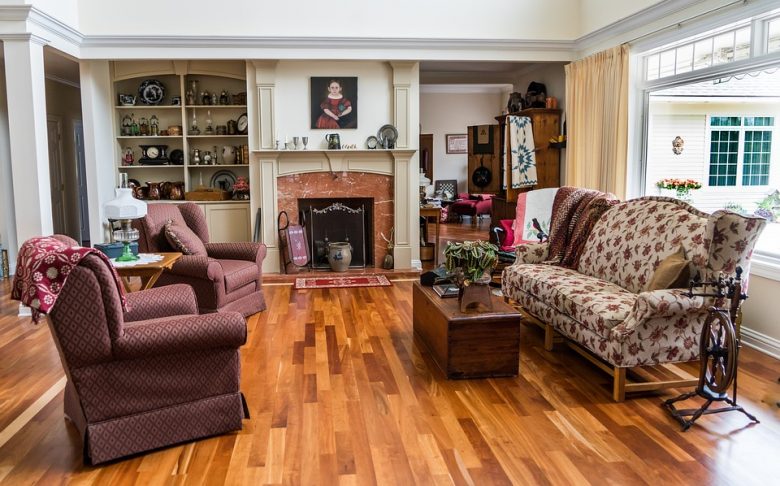Have you ever imagined yourself finding buried treasure in your home?
In recent years, homeowners have embraced the “modern” look and covered their hardwood floors with either carpet or vinyl. Now that hardwood floors are back in style, it can be a good time to check your floors. In case it turns out that the floor was one of those buried treasures, we can offer you tips for putting it back on display. However, you should be warned: this project requires a lot of patience, time, and hard work.
Prior to Starting:
Check the gaps between your floor planks. If you find that they are widening and you are able to see the nails holding the floor down, you shouldn’t even bother trying to refinish your floor.
Newer hardwood floors sometimes have a thickness of 0.25-inch with a laminate coating on top. Such floors cannot be refinished and sanded. If you try, you will probably wear away your entire floor.
It is also important to realize that it is easier to refinish some floors than others. Oak and pine, which are the most common, tend to be relatively easy to work with. Harder woods such as mahogany, maple, and walnut require more time.
Warning: Older vinyl floors might contain asbestos, either in the adhesive or the backing. You should first check with a licensed asbestos contractor before you remove the vinyl floor to ensure that the floor is safe for removal.
Preparation:
Step 1: Remove the existing floor.
You shouldn’t worry about keeping it all in one piece unless you have plans to reuse it. If fact, it will probably be easier to cut your flooring into sections so that the task becomes easier to handle. If adhesive was used on the existing floor, use some adhesive remover over any remaining adhesive and scrape it up. Doing this will help save you a lot of time in the long run.
Step 2: Remove the trim and moulding from the walls using a pry bar and wide-blade putty knife.
Exercise caution when removing these especially if they are still in good shape since they can be reused. You might have to cut a line in the paint between the wall and the trim using a utility knife.
Step 3: Remove as much debris and dirt from the floor as you can
You should also remember to check it for any nail heads that might be protruding that might tear your sandpaper. Use a nail to countersink the nail heads about 0.25inch below the floor’s surface.
Step 4: Dust Protection
The fact that sanding produces a lot of dust is hardly surprising. You can reduce cleanup time by isolating the room you are currently working on from the rest of your house. Close as many doors as possible and use plastic sheeting to cover them up. You should also cover windows, heating ducts, open door frames, shelves, and cabinets. Hold the sheeting in place using painter’s tape to ensure that it will be relatively easy to remove.
Use painter’s tape to cover all switches and wall outlets too. If you have a suspended light fixture, use a plastic bag to wrap it before you start sanding. You require adequate ventilation when sanding and even when applying the new finish. You can draw fresh air into the room using a box fan. You should also practice on a large piece of plywood until you are comfortable using the sander.
Sanding
1. Once you are done with the preparations, attach 20-grit sandpaper to the sander and start sanding.
– Work in sections measuring 2’ by 4’.
– Move in a straight path following the direction of the boards.
– Avoid grooves and dents in the wood by keeping the sander in motion at all times
– Once you are ready to begin sanding another row, overlap the previous one by one plank.
– Check the sandpaper frequently to ensure that it is not worn out or clogged.
– Keep your sander’s bag emptied regularly if it has a dust collecting system.
– Avoid pushing the sander; let it do the work. Your job is just to steer it as it pushes itself along.
2. Once you have finished sanding the main portion of the room, you now need to bring out the edge sander. Use a semicircular motion as opposed to moving the edge sander back and forth along the wall to avoid gouging the wood. Let the sander overlap a previously sanded area to ensure that it blends in.
3. Use sandpaper and a razor-sharp wood scraper in hard-to-reach areas such as corners to sand all the way to bare wood.
4. The initial sanding will actually raise the grain of the wood. Use 60-grit sandpaper to repeat the sanding procedure to get rid of scratches and blemishes. Start at the opposite end of the room from where you started sanding the first time.
5. You require a power buffer for your third and final sanding. Attach a 120-grit sanding pad to the buffer and use an irregular sweeping motion to work it across the grain. Start at the opposite side of the room from where you started the second sanding and cover the whole floor. To ensure proper coverage, overlap areas that have just been sanded. Still, you need to be careful to avoid over-sanding.
6. Spot-check the floor to ensure that you haven’t missed any areas. If you find any missed spots, use fine-grit sandpaper to hand-sand them until they match the rest of the floor.
7. Now that you have finished sanding, it is now clean-up time. Use an industrial grade vacuum to remove fine dust particles from the floor. Industrial vacuums typically come with a soft-bristle hardwood floor attachment. In case yours does not have one, attach painter’s tape to the edges of the floor attachment to ensure that it does not scratch up the floor. For the best performance, check and change the filter on the vacuum cleaner frequently.
8. Once you have finished vacuuming the floor, remove all the plastic sheeting and tape from around the room, and vacuum everything else i.e. walls, outlets, windows, cabinets, etc. Be as thorough as possible since dust can cause rough spots in case it gets into your sealant. Finish by using a wet cloth to wipe everything and vacuuming the floor one last time.
The Big Finish

1. Now that you have finished sanding and cleaning, it is time to expose the floor’s beauty. To start the sealant application process, use a 4-inch Chinese bristle brush for cutting in the areas around the room’s perimeter. Work in the direction of the wood grain and cover an area about 12-inches from the wall towards the room’s center.
2. Once you have finished the perimeter, you can start covering the rest of the floor. Apply your sealant using a lambs-wool applicator. To ensure proper coverage, overlap the areas where you earlier cut in.
3. Let the sealant dry for 24 hours and then use a power buffer to buff it. Vacuum the residue then apply another coat using the same procedure as before. You can use the same procedure for applying the sealant to stain the floor. However, you should keep in mind that this will extend the project by about 1 day. If you are not sure whether to use a water-based or oil-based sealant, you should consult a professional. It is usually just a matter of personal preference. If you opt for the oil-based sealant, you will require a respirator during application.
